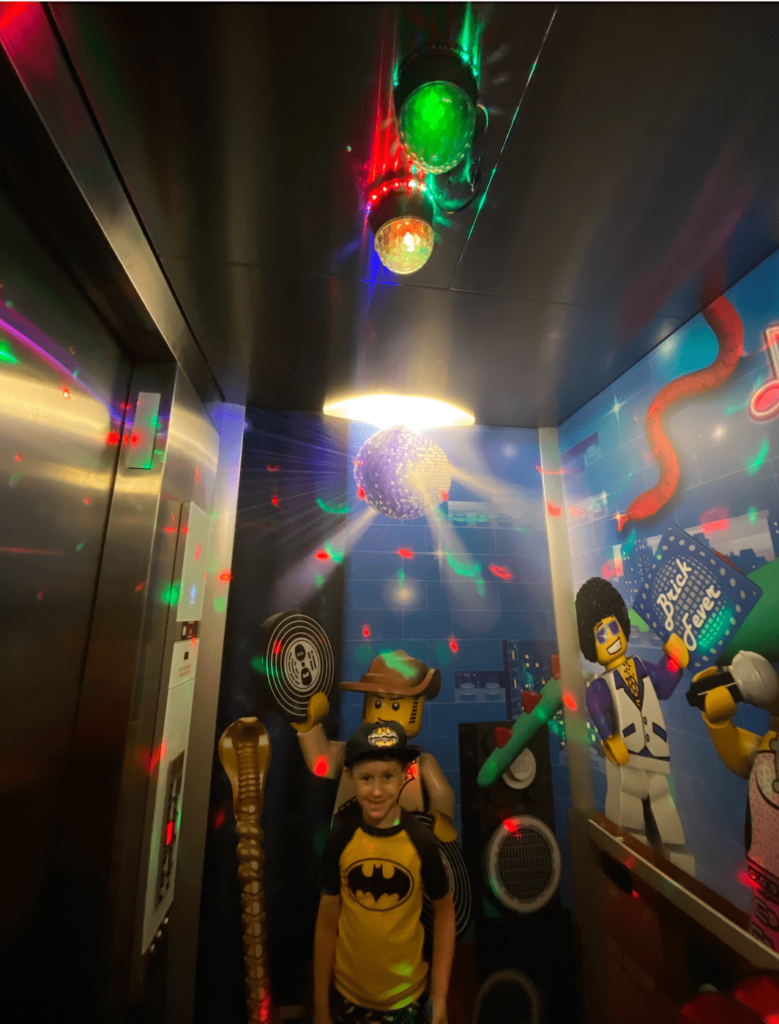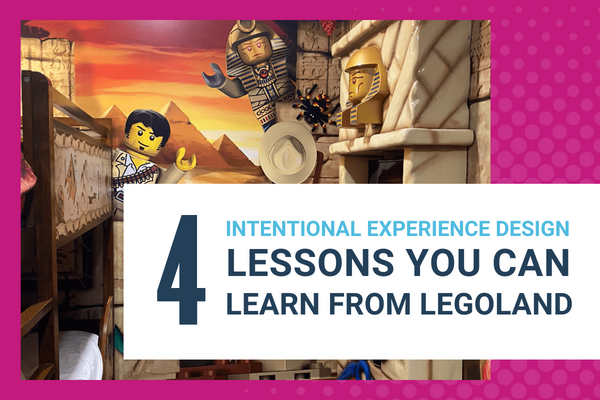I can’t help but notice awesome experience design out in the wild. A few months ago, my family spent a week in Florida and I was WOWed by the intentional experience design at LEGOLAND.
If you haven’t been to LEGOLAND resort in Winter Haven, Florida yet, I highly recommend you check it out. Even if you don’t run a theme park or work in entertainment, there are so many incredible lessons you can adopt for your own CX program.
- What is intentional experience design?
- 1. Be intentional with your first impressions
- 2. Find ways to tell your brand story everywhere
- 3. Turn a perceived negative into a positive
- 4. Don’t settle for “good enough”
- LEGOLAND through the SUPER Model lens:
- S: Start with your story
- U: Understand your customer’s story
- P: Personalize
- E: Exceed Expectations
- R: Repeat
What is intentional experience design?
Before we dive into my biggest takeaways from LEGOLAND, you should first familiarize yourself with intentional experience design.
Intentional experience design means examining every part of a customer’s experience and looking for ways to improve upon it, from the time your category first pops into their mind until they’ve been a loyal customer for decades.
Behind every touchpoint should be a purpose. When you design your customer journey with purpose, you’re more likely to solve your customers’ problems. For every touchpoint, ask yourself, “Is there something I can do to elevate this interaction into a memorable experience?”
It doesn’t have to be complicated, or even cost a lot of money. My kids are thrilled when they’re offered a sticker or a lollipop when they accompany me through a check-out lane. Retailers intentionally add this experience to alleviate the stress of parents waiting in long lines with their children.
Intentional experience design is all around you. Why do you think grocery stores always place their giant freezers of ice at the front of the store? They don’t want their customers to have to lug around melting bags of ice during their shopping trips. Instead, they purposefully have the freezers at the front of the store so you can grab it on your way out.
Every member of your team can play a role in intentional experience design. Challenge them to think of on-brand ways to add more net positive experiences to their daily interactions with customers and colleagues and your story will come to life like never before.
Taking my kids to LEGOLAND was like attending a master class in intentional experience design. They identify ways to transform ordinary interactions into experiences and infuse their brand story everywhere. Here are my biggest customer experience takeaways from LEGOLAND that you can implement in your business:
1. Be intentional with your first impressions
From the moment you drive onto the LEGOLAND property, you are fully immersed in the world of LEGO, almost like a movie set. There are larger-than-life LEGO statues everywhere. As soon as you walk into the lobby, there’s a huge castle and lego station for the kids to play in while the parents check-in. It doesn’t matter what age you are, there’s no way anyone can drive into this resort and not feel excited.
As much as we say we shouldn’t judge books by their cover, we all know people do. That’s precisely why first impressions matter. LEGO nails it.

Whether you’re walking into a restaurant, a salon, or even a business meeting, your first impression can immediately impact your experience with a business before you interact with a single employee.
Not everyone can build a magical structure to welcome their guests. But you can make sure that your store or restaurant is clean and organized. Are your employees present, attentive, and smiling, or are they nowhere to be found?
If you’re a salesperson conducting virtual meetings, are you always on time for your Zoom or Teams meetups, and is your background professional and free of distractions? There are SO many little details within your control that can make or break a customer’s experience with your business before they even interact with you.
2. Find ways to tell your brand story everywhere
Every INCH of our hotel was cleverly branded with LEGO bricks. From hallways to shampoo bottles to signs on the wall, LEGO was telling its story everywhere. Would standard shampoo and conditioner bottles be acceptable? Absolutely. But the more a brand can infuse its story in every interaction, the stronger the connection the customer will have.

Your brand may not have as many physical opportunities to tell its story, but there are endless ways to infuse more of your uniqueness into your customer journey. Every touchpoint matters. Chewy employees sign their emails with things like “Chow-chow for now!” and “Over and snout!” What are some of the touchpoints you can customize to better show off your uniqueness?
3. Turn a perceived negative into a positive
The elevators at the LEGOLAND resort are unlike any I’ve ever seen in my life. Why ride in a dark, boring elevator when you can join a disco dance party? As soon as you press the button for your desired floor, “Dancing Queen” by ABBA or “Stayin’ Alive” by Bee Gees plays over the speaker and strobe lights start spinning.

It wasn’t until my fifth elevator ride that I realized it was probably the slowest elevator ever. With so many young families at LEGOLAND, the transitions can take a while. Only one or two large strollers can fit into one elevator at a time, so you end up waiting for several minutes for people to load in and load out.
However, when your elevator is a party, your kids might not even complain. Plus, it makes leaving any of the activities WAY less dramatic. Normally, my 4-year-old would throw a tantrum that it was time to leave the pool, but the fun elevator rides softened that disappointment just enough.

Like LEGOLAND, you can identify the potential pain points for your customers and turn them into a memorable experience. Restaurants provide decks of cards or coloring books for children while they wait to be seated. Airlines use humorous and entertaining pre-flight videos for the emergency instructions to better calm people’s nerves.
You can easily reframe what would be a negative touchpoint into something really special — and even on-brand!
4. Don’t settle for “good enough”
The intentional experience design of this resort was truly over the top. They didn’t stop at the immersive building classes or floating LEGO blocks in the pools, or even with life-sized LEGO decals on the walls. They doubled and tripled down everywhere, making it unforgettable.
LEGOLAND elevates the ordinary into magical experiences. When you check into your room, your children are immediately assigned a challenge to unlock the safe. The kids have to find all of the clues around the suite until they finally find the safe – which was filled with LEGOs. Watching your parents unpack the suitcases and settle into the hotel room is usually a boring and unmemorable experience. Not at LEGOLAND. Once the hunt was over, my kids spent the next 45 minutes marveling at the LEGO wallpaper, carpet, and the dozen or more 3D brick statues all around the room.

Good companies settle for average, “good enough” experiences. GREAT companies try to blow people’s minds so that their customers cannot stop talking about them and can’t help but share their experience with their friends.
LEGOLAND through the SUPER Model lens:
Let’s take a look at how LEGOLAND’s intentional experience design fits into the SUPER Model.
S: Start with your story
From the moment you pull into the resort’s parking lot, LEGOLAND infuses their story of adventure and imagination into every possible brand touchpoint.
U: Understand your customer’s story
LEGO knows that their customers are looking for a fun and magical experience, so they create immersive moments and surprises at every inch of their resort — for kids and adults.
P: Personalize
LEGO’s intentional hotel room design divides the kid-friendly section (complete with bunkbeds and a kids-only TV) from the adult side. Although I think I would have also appreciated a “certified monster-free” bed on my side of the room, too!
E: Exceed Expectations
LEGOLAND turns even the negative experiences into memorable ones. The dance party elevator rides have ruined all future elevator rides for my children. It is, as they claim, a five-gazillion star hotel.
R: Repeat
Just when I thought I saw the most clever signage or decoration, I was wowed yet again. The resort continues to connect its story to every customer’s story and exceed expectations over and over again. One fun example? Every employee has LEGO minifigures on their nametags. Guests can swap mini-figures with any employee at any time. Talk about a fun perk!

My four-year-old has already asked me about 7,000 times, “When are we going back to LEGOLAND?!” Obviously, we were into LEGO before the vacation, but after a truly otherworldly experience at LEGOLAND, we’re true superfans.
Not only are we going to be spending even more money on the brand (my son has already spent all of the money in his piggy bank on it!), but we’re going to return to the resort and tell all of our friends to do the same. Now, when someone says the word “LEGO,” the first thing I think about won’t be stepping on those tiny bricks in the middle of the night.
Everything is experience. Every component of your experience is an extension of your story and can impact the likelihood of a buyer coming back or making a referral. The more you can craft your brand experience to engage your customers, the more time and money they will spend with you.





